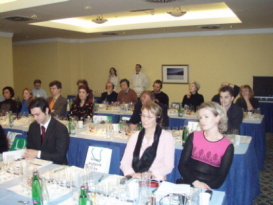 The Andalusian office Extenda and Hotel President recently organised a seminar for wine professionals about Brandy de Jerez. The tasting was conducted by Sr. Bosco Torremocha, Director General FEDEJEREZ, the association of winemakers from the region of Jerez. The Andalusian office Extenda and Hotel President recently organised a seminar for wine professionals about Brandy de Jerez. The tasting was conducted by Sr. Bosco Torremocha, Director General FEDEJEREZ, the association of winemakers from the region of Jerez.
The difference between this and other brandies (apart from location and soil) is that it is matured in 500 litre American oak barrels that have already been used in the production of one type of Sherry for at least three years and undergo the same process for maturation as sherry itself, using the criadera or solera systems. Furthermore, any product calling itself Brandy de Jerez can only be produced in the region of Jerez, which is also the same as for sherry, in the triangle between the towns of Jerez, Puerto de Santa María and Sanlúcar de Barrameda. It is principally made from the unsung but nicely acidic Airén variety assisted by a portion of Palomino. Airén incidentally is the most planted white variety in the world, planted in unusually low densities, for the most part in La Mancha region to the north, where it is slowly being replaced in favour of red varieties.
In 2005 around 80 million bottles of Brandy de Jerez were produced. Exports account for 40% of total production. As in the rest of its many markets this splendid spirit has seen a sixfold increase in consumption during the past four years.

At the Hotel President tasting, seven miniatures were set before each taster. The first three were all without colour. All samples came from Brandy de Jerez producers but with generic labelling. 1. Destilado de Melaza (Molasses distillate) - this neutral spirit has a nose reminiscent of pharmacy and a strong taste. It is meant as a guide for the tasters, not for drinking as such, but is watered down from 96% alc to make it at all palatable. 2. Destilado de Vino (Wine distillate) - burning and overpowering, fruity neutral nose with a yeasty palate and longer aftertaste. Basically an overstrength vínovice, or wine brandy, again watered down from 95% alc. 3. Aguardiente de Vino (Holanda) - wine distillate from alambic, very floral, fruity with apricots and a hint of wood even though colourless. This is the base of Brandy de Jerez. A mere 65% alc. 4. Brandy de Jerez Solera - the basic style of sherry, 6 months of age, light amber in colour and a bit rough, with a lingering spicy palate and medicinal overtones. 5. Brandy de Jerez Solera Reserva - 2 years of age, more complex with a darker hue. Woody, vanilla palate, this sample was aged in oloroso butts giving it a sweetish taste. 6. Brandy de Jerez Gran Reserva - 8-10 years old. Dark amber. Lovely mellow nose, full of chocolate and coffee flavours. 7. Brandy de Jerez Gran Reserva - age as above, but aged in casks in which the dark and luscious Pedro Ximénez sherry has matured, giving a deep almost opaque chocolate colour with a lush, long, sweet raisiny palate with figs, dates and other dried fruits, almost overwhelming the tastebuds with its richness. Other samples were then presented by importers who already have products on the Czech or Slovak markets, i.e. Sandeman Capa Negra; Terry 501 Solera; González Byass Soberano Solera Reserva; Garvey Solera Espléndido; Williams and Humbert Gran Duque de Alba Solera Gran Reserva. One of only three brandy types protected by the EU Brandy de Jerez (the other two being Cognac and Armagnac) is well worth a try.
Salud!
| 







